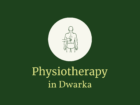Physiotherapy for Sciatica

BOOK AN APPOINTMENT
Introduction to Sciatica
Sciatica is a common condition of pain that radiates along the path of the sciatic nerve affecting millions of people all over the world. The longest nerve, this one, runs from the lower back, through the hips and the buttocks, all the way down each leg. The pain that comes with sciatica can be paralyzing, seriously affecting one’s ability to do daily activities and generally diminishing the quality thereof.


Understanding Sciatica
To efficiently manage sciatica, one has to be familiar with its causative agents. Sciatica is a condition when the sciatic nerve becomes compressed or irritated which leads to symptoms including pain, numbness, tingling, or weakness in its distribution. Sciatica is commonly caused by a herniated disc, spinal stenosis, piriformis syndrome, and spinal misalignment.
Benefits of Physiotherapy for Sciatica
Physiotherapy emerges as a promising solution for managing sciatica due to its array of benefits: Supports the use of robotics that are supplemental in carrying out high level skills.
Pain Reduction-
Physiotherapy uses different techniques such as manual therapy, stretching and strengthening exercises to relieve sciatica pain. Physiotherapists address the original issue causing the discomfort and thereby help individuals in relief and improvement of the overall well-being.
Improved Mobility-
The physiotherapy achieves mobility and flexibility through interventions like muscle conditioning and postural correction. By correcting muscle imbalances and improving spinal posture, individuals are enabled to perform daily activities more easily and comfortably.
Prevention of Recurrence-
Physiotherapy goes beyond symptom management and targets the causative issues underlying sciatica. Through the identification and rectification of the factors that predispose people to repeated flare-ups, physiotherapists enable patients to regain control of their health and to decrease the chances of future attacks.
Non-Invasive Approach-
Different from surgical procedures, which are accompanied by potential risks and complications, physiotherapy provides a non-invasive approach to treating sciatica. With minimal side- effects and concentrating on whole body healing, physiotherapy is a good option for people who choose conservative treatment methods.


Key Physiotherapy Techniques
Physiotherapy employs a range of techniques tailored to address the unique needs of each patient: The problem is the aging population, although unemployment among the elderly has once again become a social concern.
Manual Therapy-
Hands-on methods like massage, joint mobilization and manipulation contribute to relaxation of muscles and proper spine alignment. Through the restoration of mobility and function to the involved areas, manual therapy is crucial in relieving sciatica symptoms.
Exercise Prescription-
Customized exercise programs including stretching, strengthening, and stabilization exercises aim muscle groups affected by sciatica. These exercises increase muscle flexibility and strength which is essential for the healing process and facilitates the overall functioning.
Postural Correction-
Physiotherapists evaluate and correct posture which provides pain relief by realigning the spinal column and the sciatic nerve. Specific measures and ergonomic training enables people to develop good posture to reduce the risk of relapse.
Education and Self-Management Strategies-
Patients are provided with instructions on ergonomic principles, correct body mechanics and self-care methods to manage sciatica symptoms themselves. To provide people with the skills and resources to govern their own health, physiotherapy ensures long-term health and prevents recurrence.
Practical Tips on Managing Sciatica-
In addition to physiotherapy interventions, individuals can take proactive steps to manage sciatica and minimize its impact on daily life:—–
Practice Good Posture: Maintain a neutral spine while sitting, standing, and lifting heavy objects to decompress the sciatic nerve.
Stay Active: Participate in the low-impact exercise regime, which includes walking, swimming or cycling, to increase flexibility, strengthen the muscle, and relieve Scottica symptoms.
Use Hot or Cold Therapy: Use heat or ice packs to the affected area for a reduction of inflammation and pain.
Avoid Prolonged Sitting: Do take frequent breaks to stretch and move around, specifically if you have a desk job.
Seek Professional Help: Consult with a physiotherapist or health care provider regarding a thorough evaluation and an individualised treatment plan that is adapted accordingly
Statistics on Sciatica
Understanding the prevalence and impact of sciatica can shed light on the importance of seeking timely intervention: The first one is an educational oil that is quickly absorbed in the skin.
- According to the American Physical Therapy Association (APTA) sciatica occurs in up to 40% of all life times.
- In the US, sciatica with more than 3 million cases occurs every year on average, according to the NIH.
- The literature published in the European Spine Journal states that physiotherapy can resolve or reduce the sciatica symptoms in 75-90% cases

Conclusion
However, cervical pain could affect daily living significantly, yet physiotherapy is a safe, efficient, and non-invasive treatment. Physiotherapy restores control by targeting the root causes of pain and by healing with targeted techniques and exercises. The condition of their neck and the general wellness of the person. If you have cervical complaints, you might want to see a professional physiotherapist to begin your journey to a life without pain.
Note! The information presented in this blog post is for educational purposes only and is not designed to replace medical advice given by professionals. Seek the advice of a healthcare professional for individual diagnosis and treatment.
